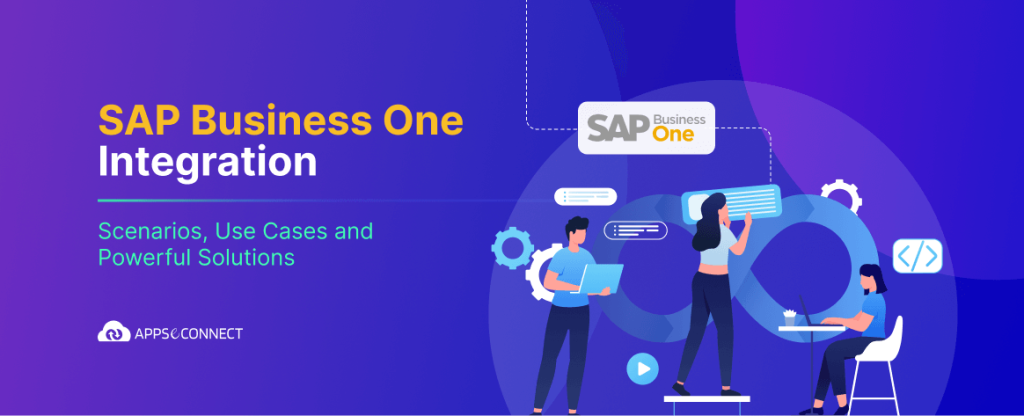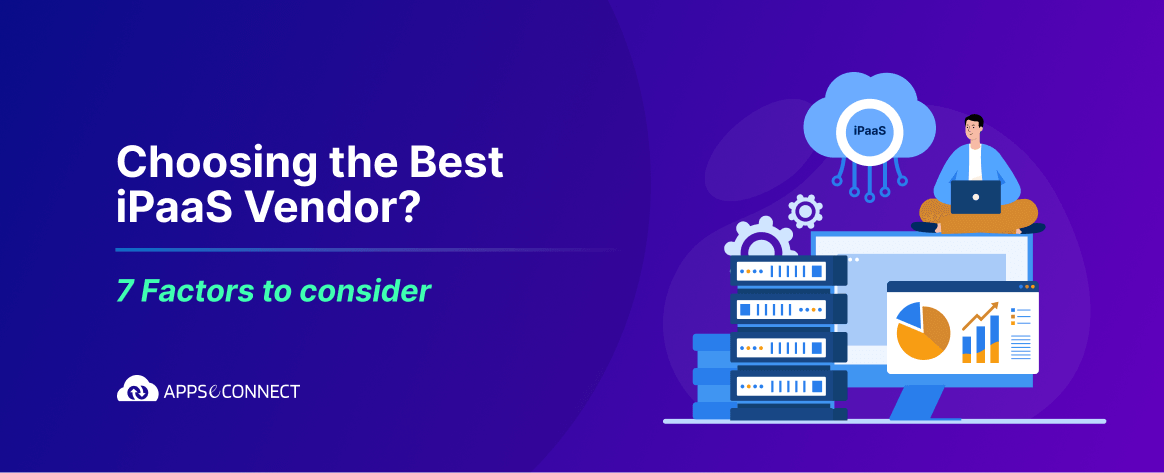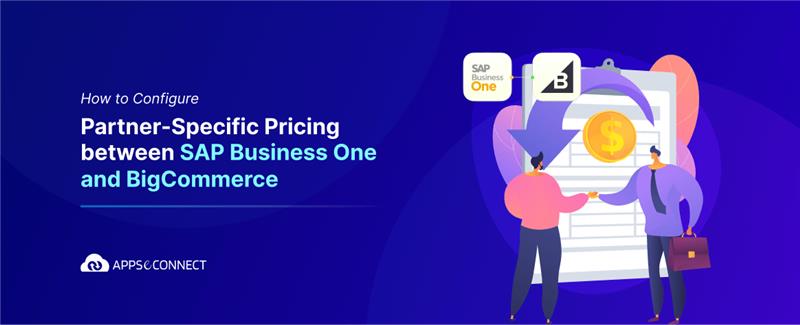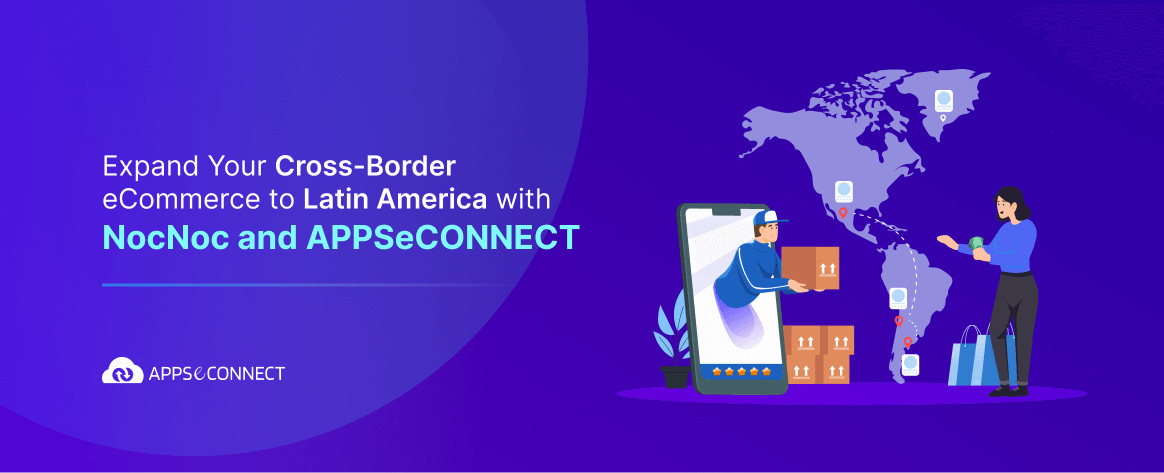Industries all over the world are witnessing a rapid digital transformation. This digital transformation is powered by enterprise resource planning (ERP) systems such as SAP Business One, a powerful tool capable of managing all business operations across various industries. However, true digital transformation extends beyond a robust ERP at the core; it requires seamless connections with other best-of-breed business applications, such as customer relationship management (CRM) systems, marketplaces, and eCommerce platforms. Deriving key insights from my years of experience in SAP projects and integration solutions, I have prepared a comprehensive guide for SAP Business One integration scenarios. Discover the growing need for SAP Business One integration, the significant benefits of these integrations, and all the powerful solutions offered by APPSeCONNECT to synchronize SAP Business One with other top enterprise applications.
The Need for SAP Business One Integrations
SAP Business One is utilized by over 75,000 businesses globally, making it the flagship product of SAP SE for mid-sized enterprises. These businesses are often at a pivotal stage of growth, where digital transformation, powered by a robust ERP system, can significantly accelerate their progress.
However, businesses don’t rely solely on an ERP system. They also invest in other best-of-breed applications tailored for specific business processes.
For example, a CRM system is essential for managing prospects, nurturing leads, and maintaining customer details, while an eCommerce platform is crucial for businesses with an online store. When a company uses one or more such systems alongside SAP Business One, the need for integration arises.
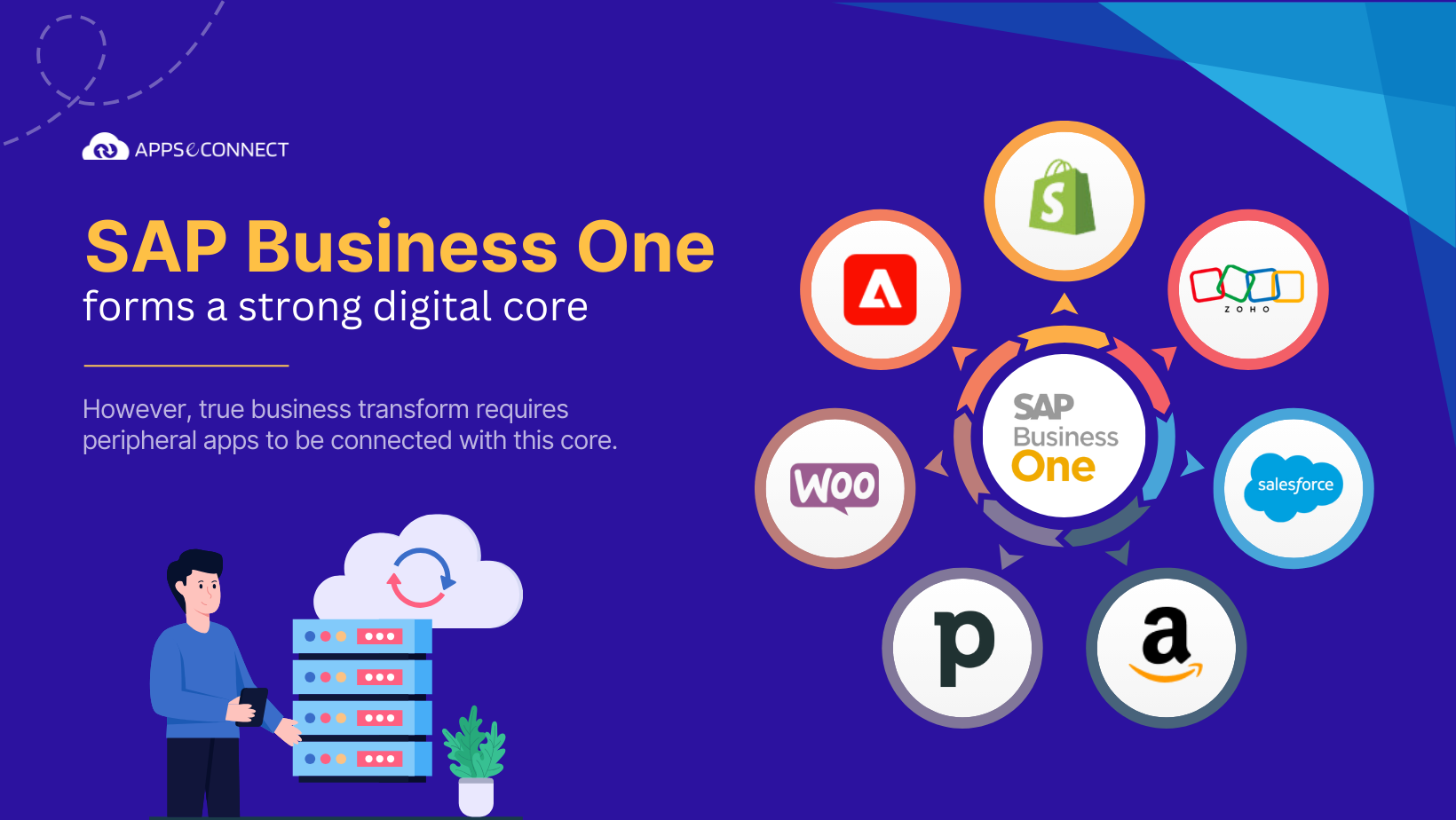
At APPSeCONNECT, we are frequently approached by businesses that deal with hundreds or even thousands of data points daily, such as sales orders, product details, inventory levels, payment and invoice info, etc. Syncing all that data across different systems consumes considerable man-hours, costing time and money, but ultimately slowing down business processes.
Even after implementing the best enterprise applications around the ERP core, siloed data still remains a huge bottleneck for such organizations. At this critical juncture, integrating the ERP system with other peripheral apps becomes a critical necessity for businesses.
SAP Business One Integration Capabilities
APPSeCONNECT has established itself as a leading integration platform for SAP Business One in recent years. But, my own experience with SAP projects extends to more than a decade. Back then, integration projects were complex with extremely limited capabilities.
Fast forward to today, and SAP has rapidly evolved its wide range of products and solutions. In fact, they continue to push for technological and operational innovations year after year. With recent changes in 2024, SAP Business One has also received some excellent upgrades.
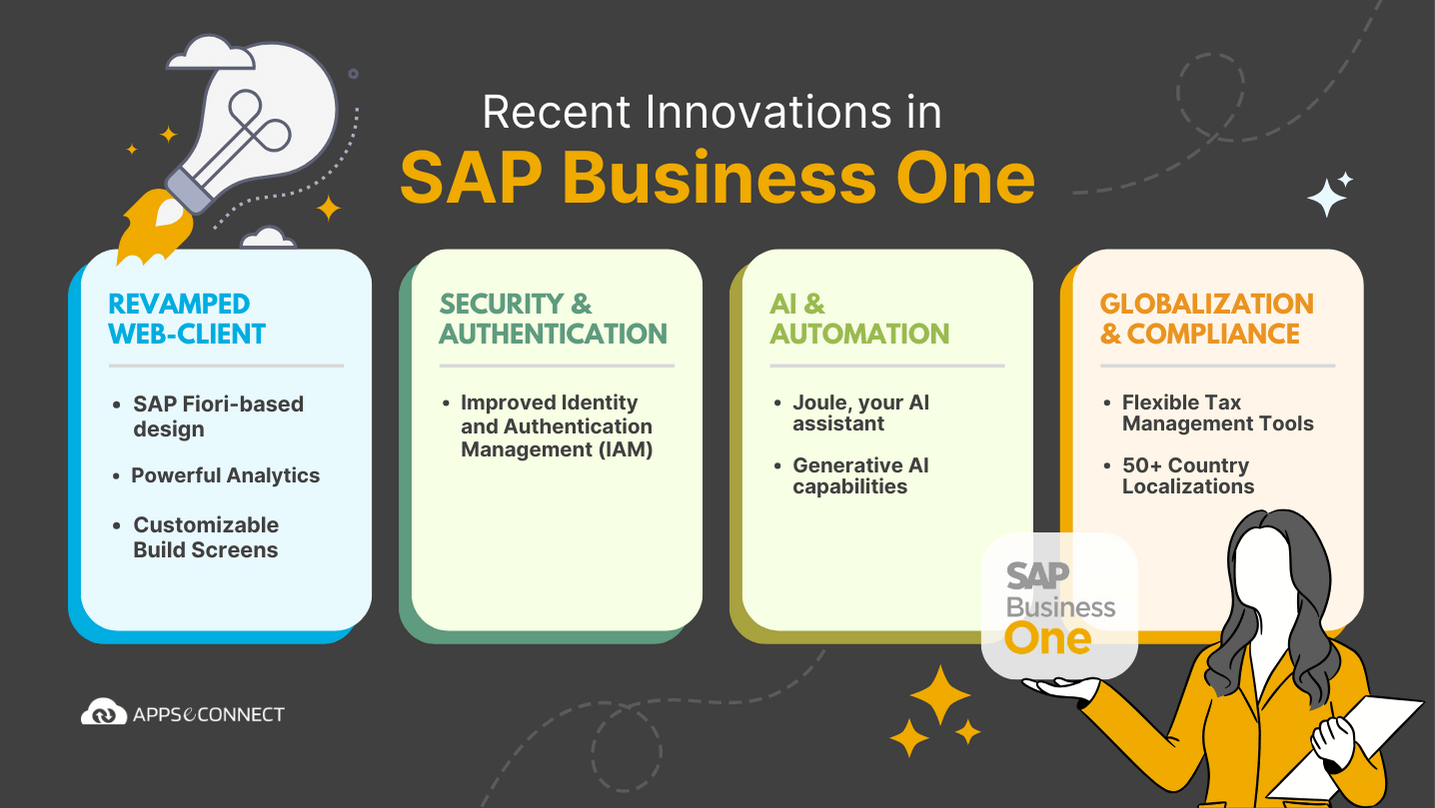
The service layer provides a robust methodology to develop integration, available for both HANA and SQL-based deployments. From our experience, this method is far more robust and scalable compared to the previous, now outdated, DI Server-based integration.
If you would like to know more about SAP’s future plan, don’t miss out on this detailed post where my colleague shares his take on SAP’s decade-long roadmap for their ERP solutions.
SAP Business One Integration Scenarios
Having understood the growing need for SAP Business One integration, it’s also important to understand the different scenarios for connecting SAP with other systems.
I’ll cover the most popular and essential integration scenarios, putting them into distinct categories based on the types of enterprise apps that businesses commonly integrate with SAP B1.
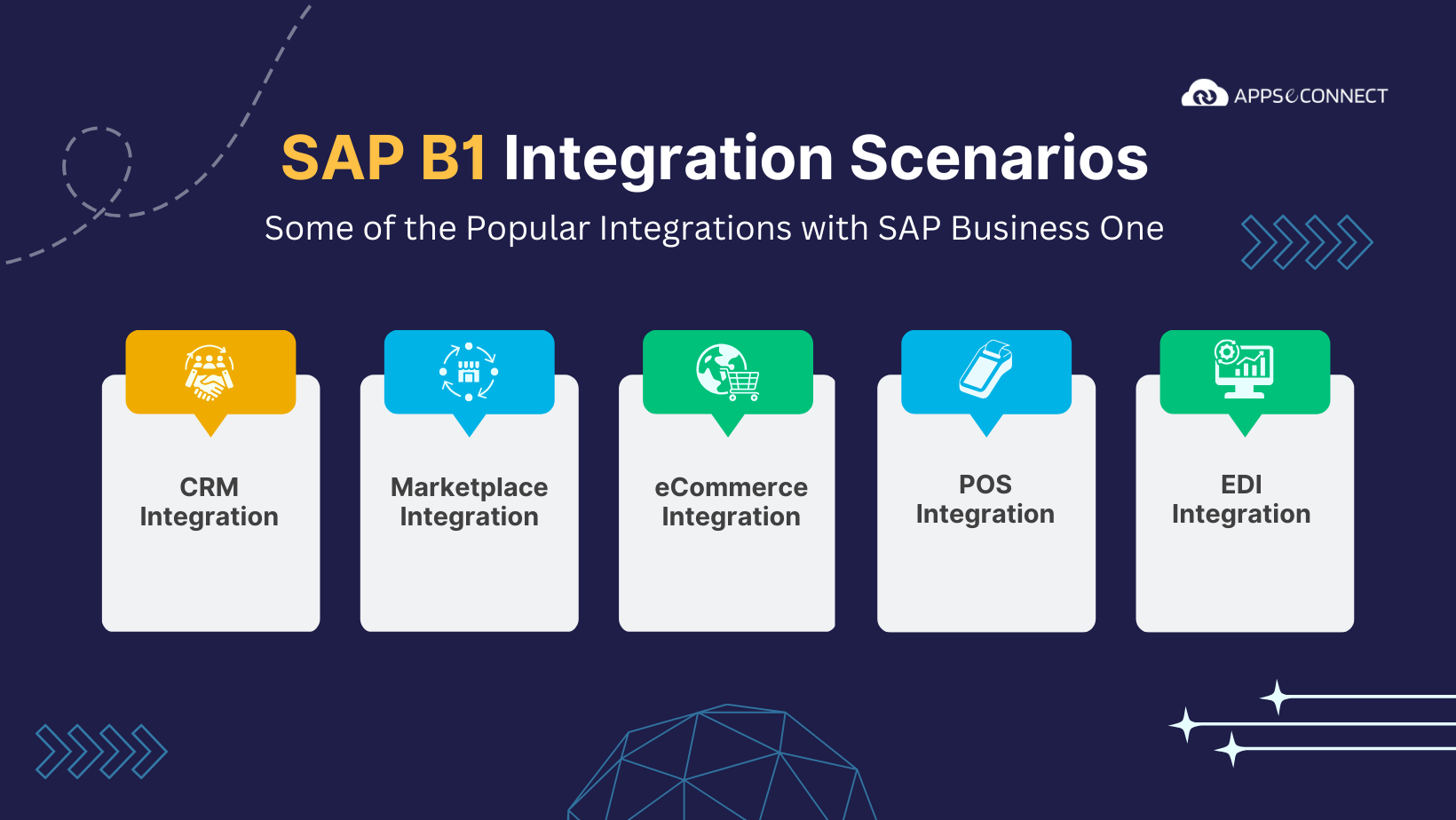
SAP Business One CRM integration
Customers lie at the heart of every successful business, and sales teams who deal with these customers are the profit centers for any organization.
While SAP Business One offers robust functionalities for managing customer data, it can be overwhelming for sales teams to use it daily. Also, an ERP system may not delve into the more nuanced aspects of customer relationships. This is despite having all master records and pricing information within the application.
And that is where powerful CRM tools come into play, enhancing businesses’ capabilities in recording customer data and extracting actionable insights to foster enduring relationships.
CRM systems are pivotal in modern business strategies, enabling organizations to centralize customer interactions, automate sales processes, and deliver personalized experiences. By consolidating customer data across various touchpoints, CRMs empower sales, marketing, and service teams with comprehensive insights into customer behaviors, preferences, and needs.
However, to fully leverage the capabilities of both SAP Business One and CRM systems, integration between these platforms becomes imperative.
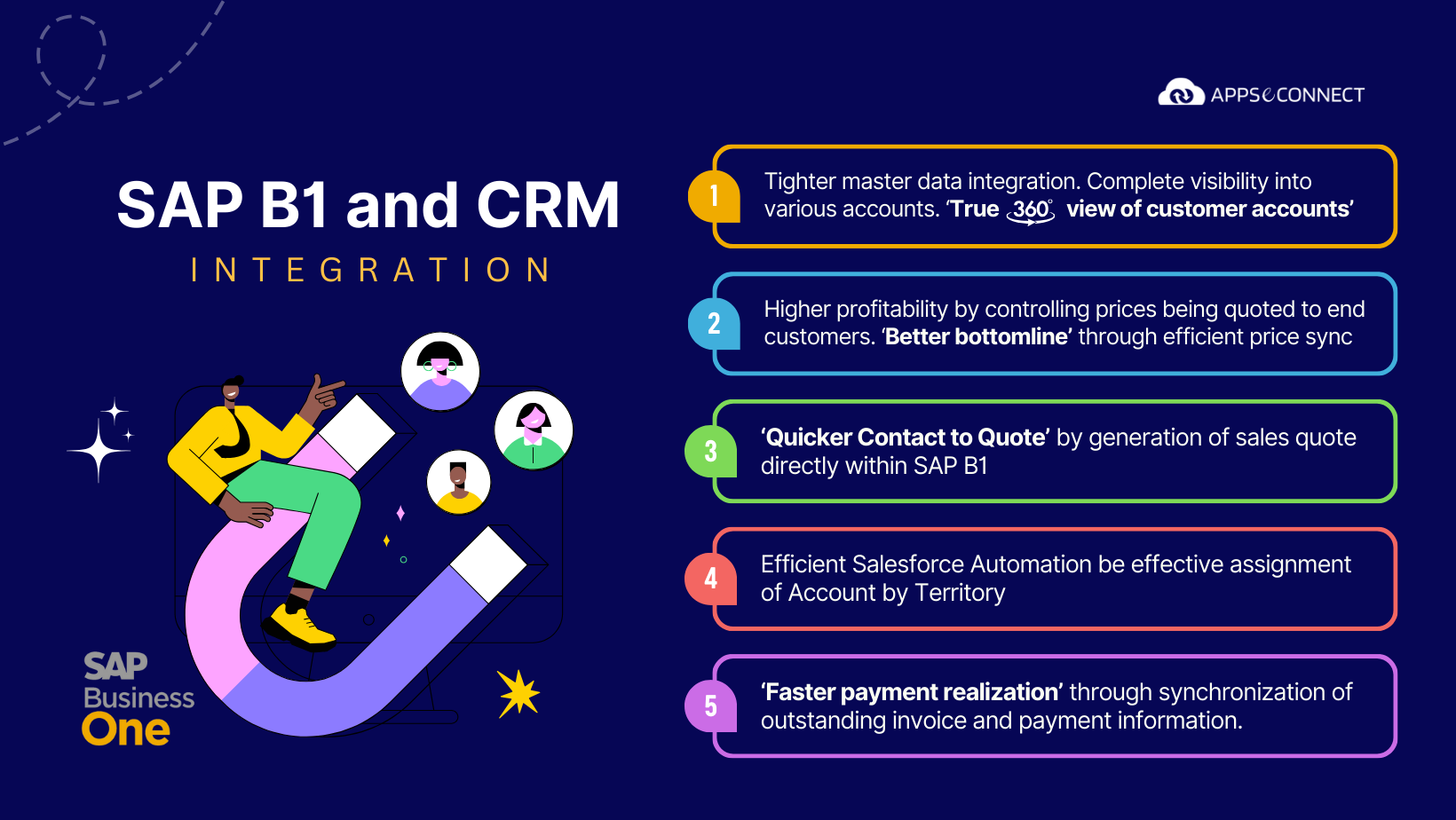
By integrating SAP B1 with a CRM system, businesses can enhance data accuracy and streamline business processes from lead generation to order fulfillment and customer support. It facilitates a unified approach to customer relationship management, where every interaction is informed by up-to-date insights.
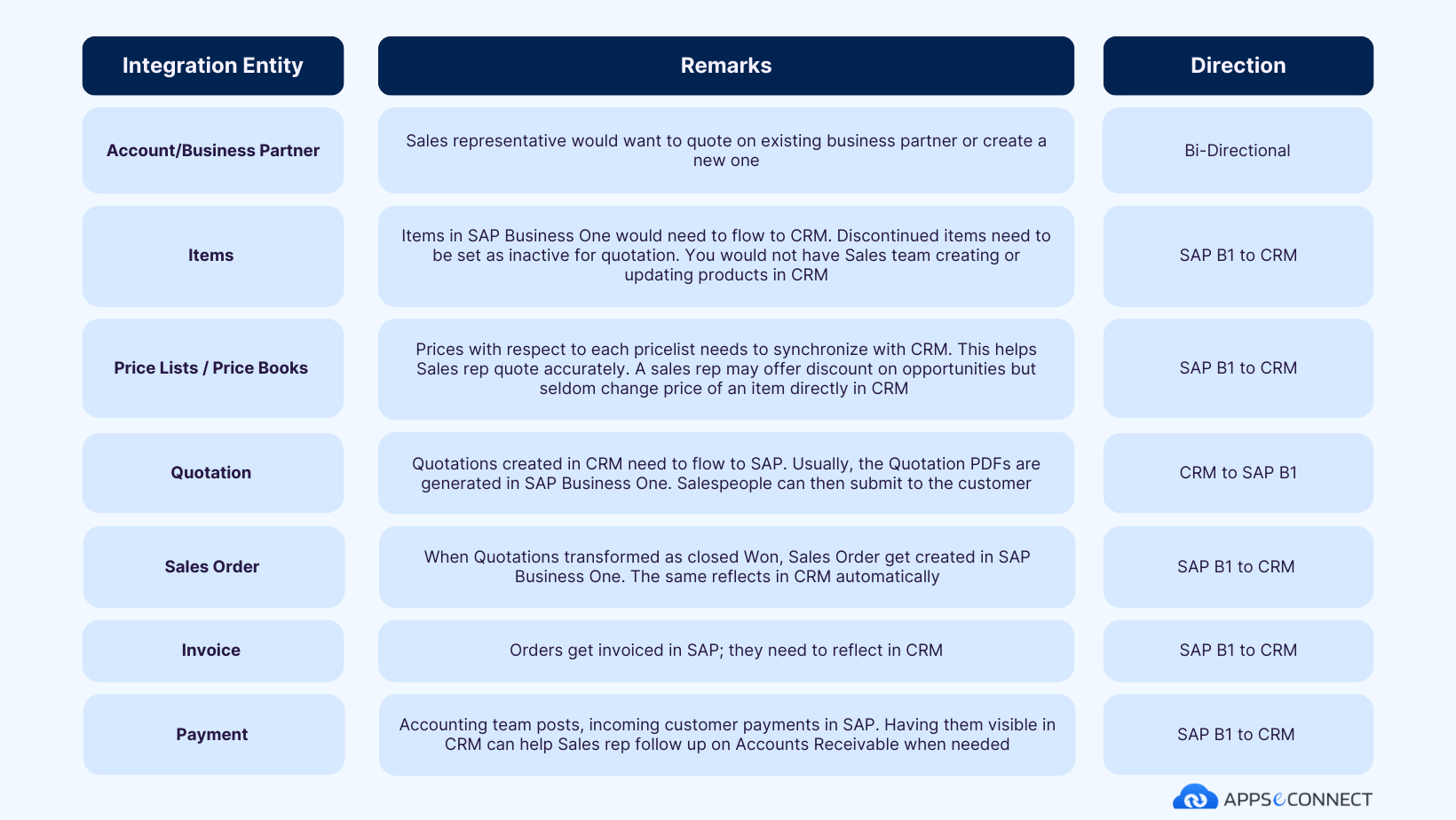
Here are the top SAP Business One and CRM integrations that businesses commonly use and require.
SAP Business One Salesforce Integration
Salesforce has truly revolutionized the SaaS market with an enterprise-grade CRM application. Most upper mid-market customers naturally choose this platform due to its powerful features. By seamlessly connecting these platforms, organizations can unify their sales and customer data, ensuring a holistic view of customer interactions across the entire lifecycle.
Click here to explore APPSeCONNECT’s SAP Business One and Salesforce Integration.
Zoho CRM integration with SAP Business One
A more affordable alternative to Salesforce is Zoho CRM. Smaller to mid-size customers are increasingly adopting the platform and benefitting from its user-friendly but impactful features. Integration between the platforms includes synchronization of business partners, items, opportunities, quotations, and orders.
Click here to explore APPSeCONNECT’s SAP Business One and Zoho CRM Integration.
SAP Business One and HubSpot Integration
HubSpot is one of the most popular CRM platforms to have risen in recent years. Its integration with SAP Business One involves synchronizing companies/business partner information along with their respective contacts. Also, whenever a deal is created in HubSpot, it synchronizes with SAP as Sales Orders or Opportunities.
Click here to explore APPSeCONNECT’s SAP Business One and HubSpot Integration
Some of the other popular CRM integrations with SAP Business One include
SAP B1 and Microsoft Dynamics 365 integration
SAP B1 and SugarCRM integration
SAP Business One Marketplace Integration
Marketplaces like Amazon have become indispensable channels for businesses to achieve high-volume sales and build customer trust. One of our customers receives about 800 marketplace orders per day, showcasing the immense potential of these platforms.
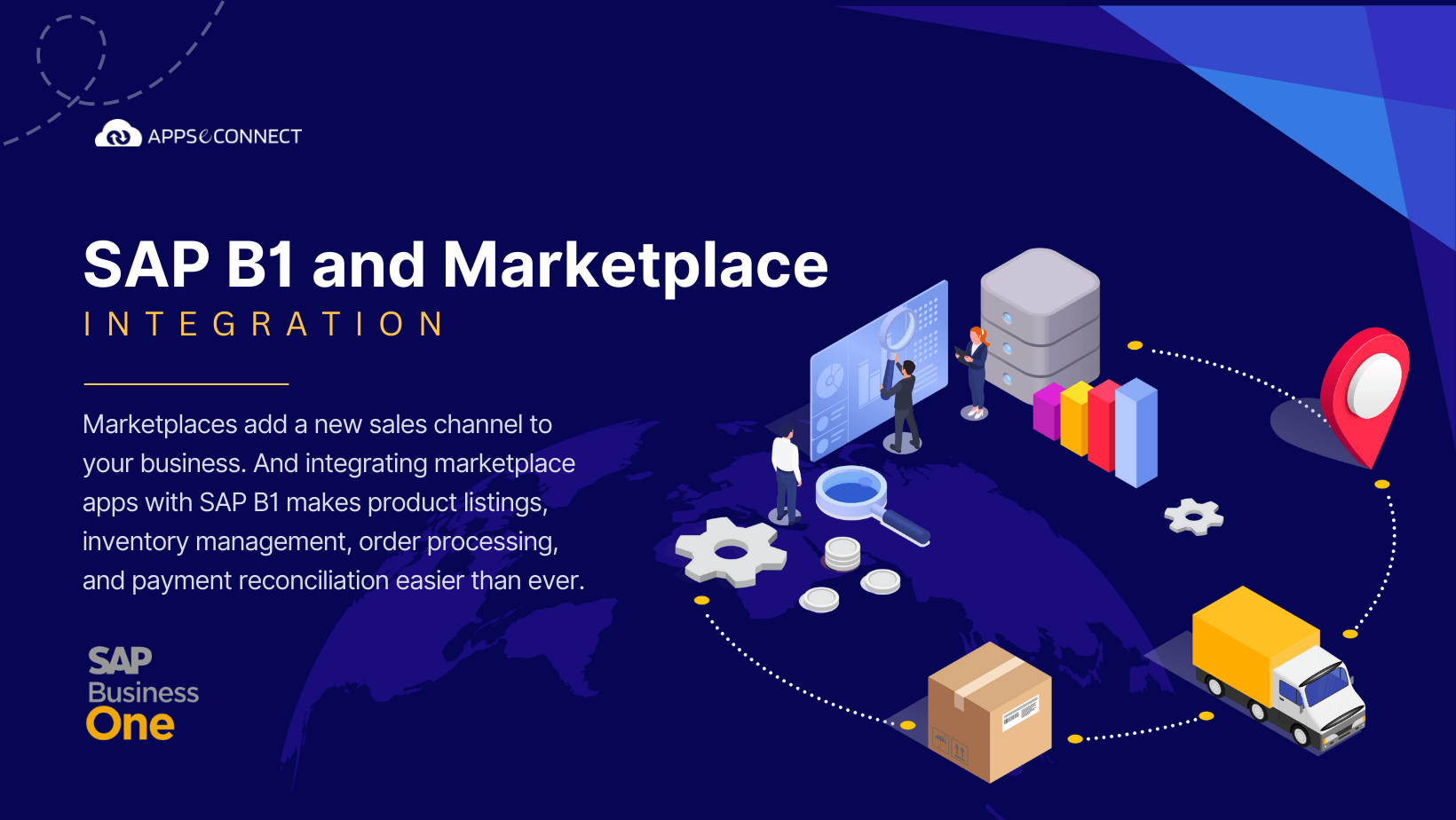
Marketplaces are more than just sales channels; they are also powerful tools for customer acquisition and retention. By synchronizing SAP Business One with these platforms, businesses can automate the flow of data, reducing manual effort and minimizing errors.
Integrating SAP Business One with marketplaces such as Amazon streamlines order processing, enhances inventory management, and ensures pricing consistency.
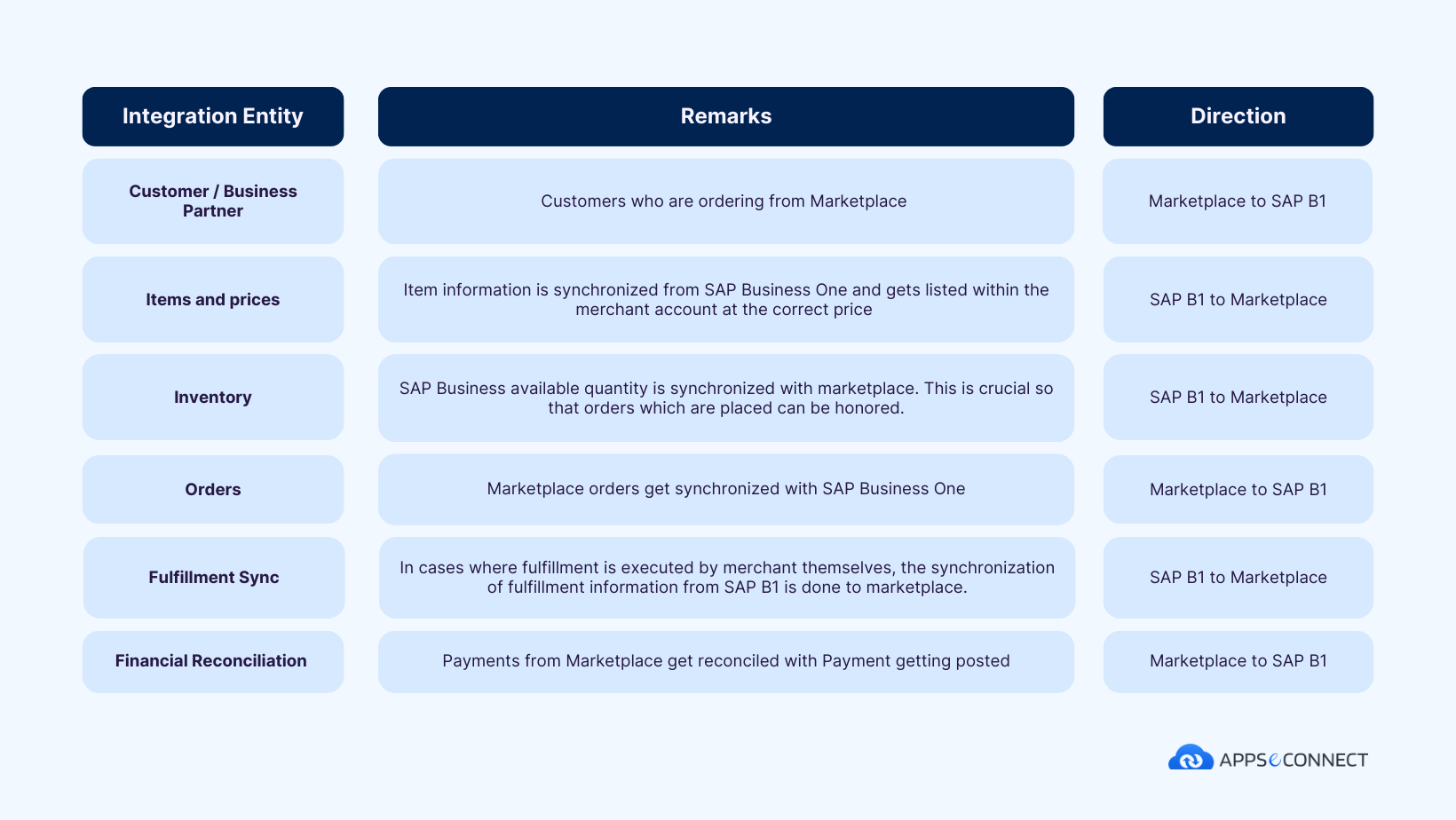
Here are some prominent integrations in this category.
SAP Business One and Amazon integration
Amazon has established itself as the global giant of marketplaces. Due to its customer first approach, it has become a trusted name among many retail buyers. For any popular, fast-growing brand, if you’re not selling on Amazon, you’re missing out on countless sales.
On the other hand, when you start selling and get bulk orders, integrating Amazon with SAP B1 becomes essential.
Our SAP Business One integration with Amazon includes both Fulfilled by Amazon (FBA) and Fulfilled by Merchant (FBM) scenarios. In the former, merchant keeps a stock at Amazon Warehouse and latter takes care of handling fulfillment and warehouse operations. In FBM, merchants fulfill the order from their warehouse.
Click here to explore APPSeCONNECT’s SAP Business One and Amazon Integration
SAP Business One and eBay Integration
eBay is a prominent marketplace in certain niche like luxury goods, electronics, bags, furniture. eBay integration with SAP Business One makes it convenient to list merchandise on eBay and push the sales order into SAP B1 in a streamlined manner.
Click here to explore APPSeCONNECT’s SAP Business One and eBay Integration
SAP Business One and Walmart Integration
Walmart has become another hugely popular marketplace in the US. Its integration with SAP helps merchant list their merchandise on Walmart, and also get Walmart orders posted into SAP Business One using Webservices.
Click here to explore APPSeCONNECT’s SAP Business One and Walmart Integration
SAP Business One and Wayfair Integration
Wayfair is the favorite marketplace for home furnishing and décor items. Companies in this industry vertical need SAP Business One to integrate with Wayfair.
Click here to explore APPSeCONNECT’s SAP Business One and Wayfair Integration
SAP Business One eCommerce Integration
Multi-channel commerce has become necessary even for mid and upper mid-sized companies today. Several eCommerce platforms have risen in the last decade, making it quite easy and accessible for merchants and businesses to launch their own Web Shop.
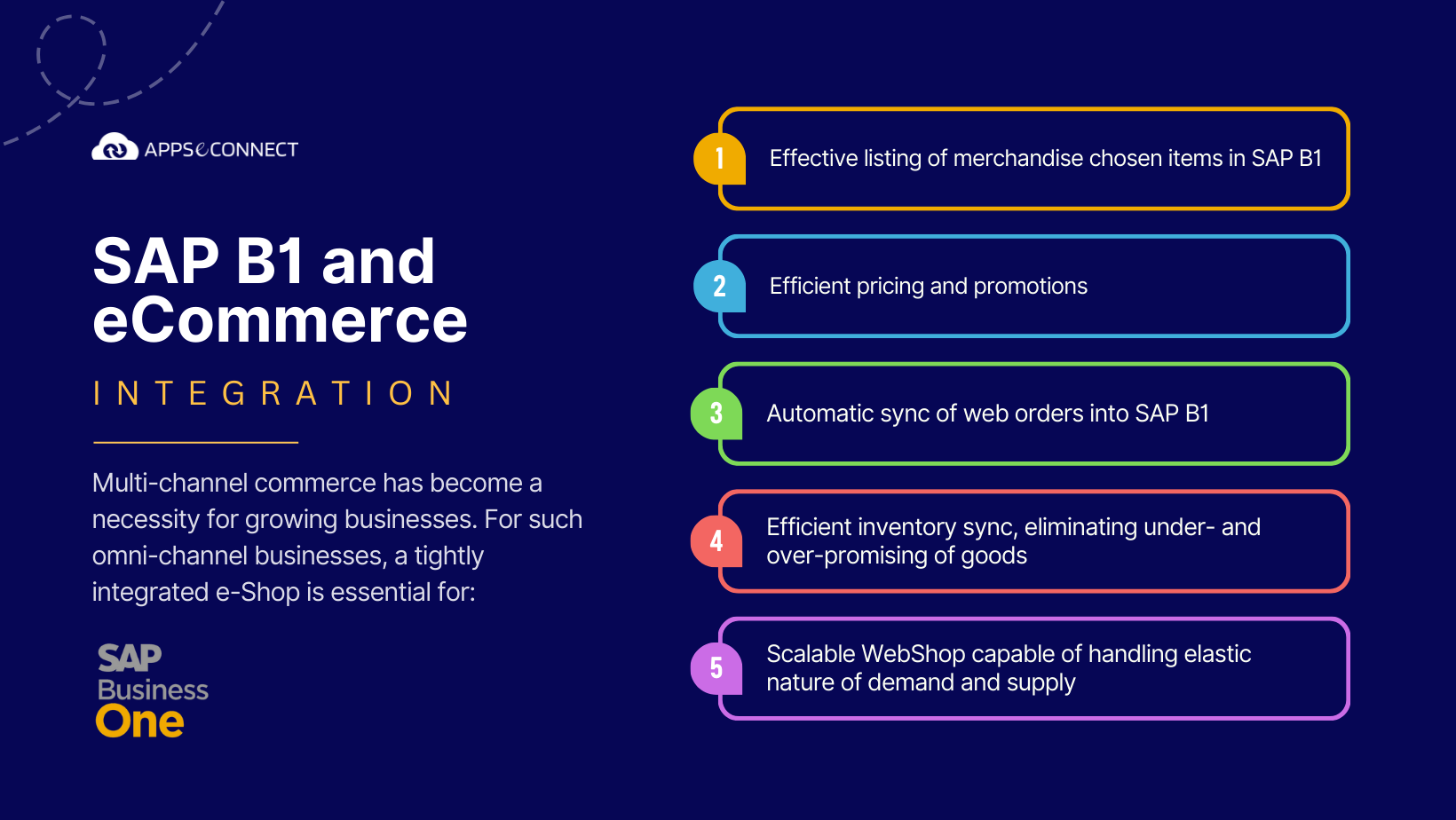
Integrating eCommerce application with SAP Business One is important to ensure master data is synced, transactions are reflected in both the application and control mechanisms and business checks are in tandem.
Following are the integration points.
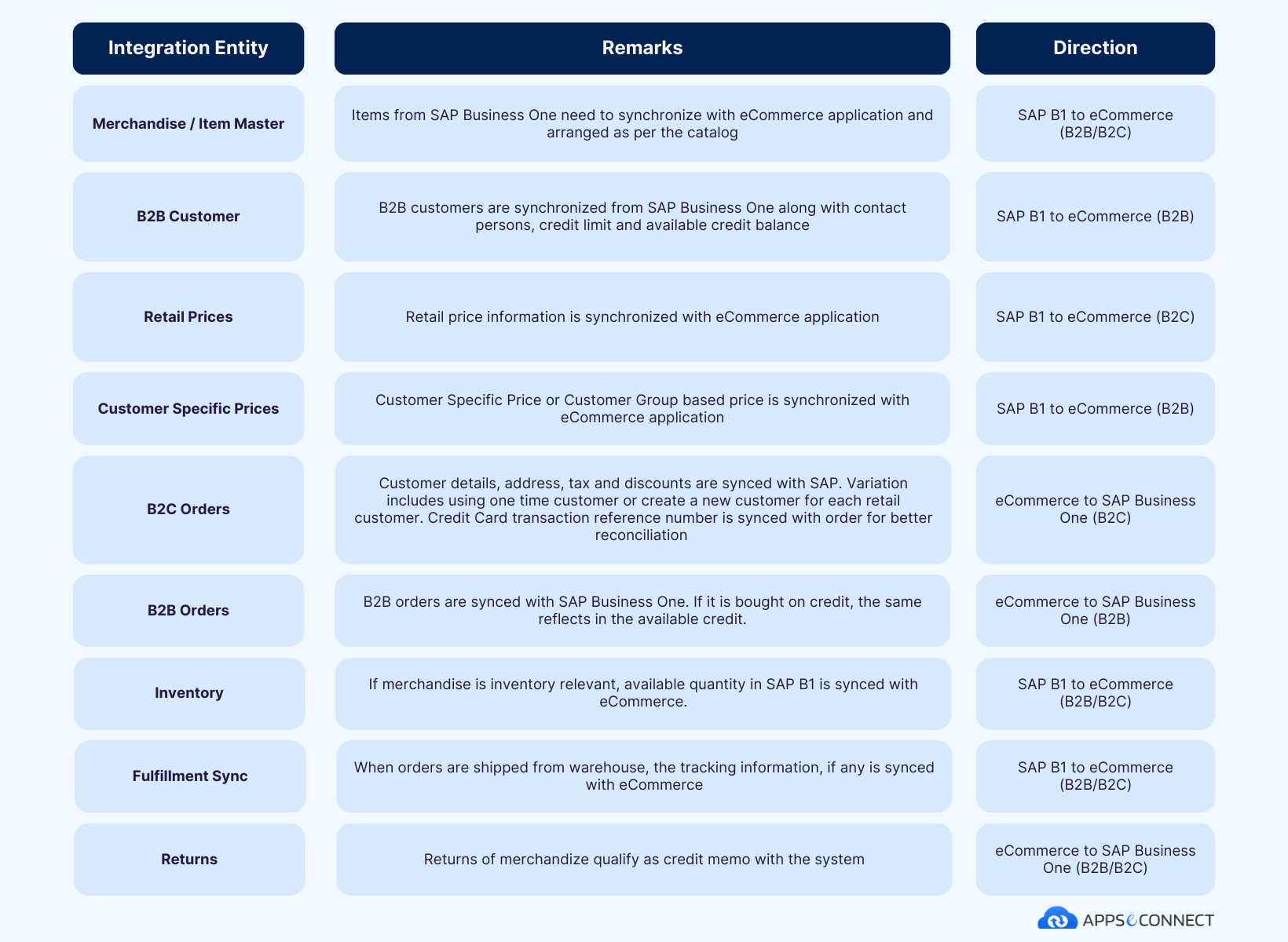
Let’s go through the top SAP Business One integrations with eCommerce applications.
SAP Business One and Shopify integration
Shopify is one of the biggest eCommerce platforms for mid-sized companies, and its integration with SAP Business One makes it possible to list Web items along with their attributes and synchronize the online orders seamlessly in SAP Business One. This is primarily a B2C integration. However, Shopify Plus also offers B2B features and can be integrated with SAP Business One.
Click here to explore APPSeCONNECT’s SAP Business One and Shopify Integration
Additional: SAP Business One and Shopify Plus B2B Integration
SAP Business One POS Integration
Retail stores need to manage customer checkout efficiently using a POS system. Though at surface level, operating the system may look easy, complexity in integration multiplies with the number of SKUs, retail outlets, retail transactions and inventory handling.
That is why a reliable integration solution is essential between SAP Business One and POS systems.
The following are the integration points when it comes to integrating SAP Business One with POS solution using APPSeCONNECT.
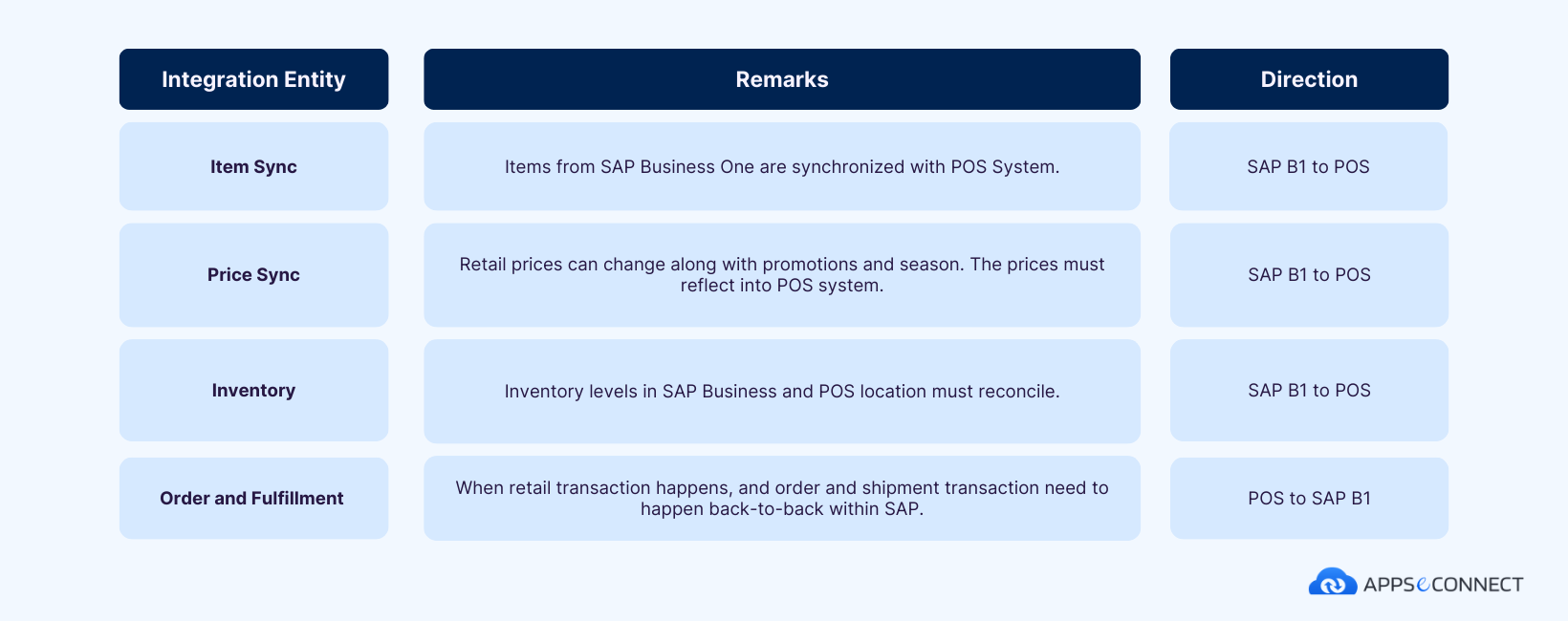
Click here to explore APPSeCONNECT’s SAP Business One and LightSpeed integration works.
Best Practices while integrating SAP Business One
Some of the best practices that one must ensure while developing SAP Business One integration are as follows:
Factor in Scalability
At APPSeCONNECT, we recognize that businesses can scale rapidly. An integration that handles 30 records per day efficiently might struggle when the volume increases to 2,000 records per day. Planning for scalability from the outset is crucial.
Data Duplication Handling
Duplication of data during integration can have a significant impact on business operations. For instance, if a duplicate web order results in two shipments, the costs associated with return logistics can be substantial. Ensuring mechanisms to handle and prevent data duplication is vital.
Cross Reference IDs
Business users often need to refer to the same record in multiple systems. It is important to maintain cross-referenced IDs. For example, a customer support representative may need to search SAP using a Shopify order number while assisting a customer over the phone.
Respect Foreground Users
System integration should aid, not hinder, the work of foreground users. Integration processes should not consume excessive system resources, impacting the performance of other users. Intensive operations should be scheduled for off-peak times, such as the end of the day or early morning.
Factor in Indirect User Licensing
SAP licensing has specific policies regarding system integration, particularly concerning indirect access. Understanding SAP B1’s indirect access policy is crucial before embarking on SAP integration projects.
Pre-built integrations
While custom integration may appear cheaper initially, it often becomes more costly and limiting over time. Maintenance, upgrades, and fixes for custom integrations can add up. Time-tested pre-built integrations offer a more reliable and cost-effective solution.
About APPSeCONNECT
Unlock the potential of intelligent integration with APPSeCONNECT, a cutting-edge, low-code integration platform engineered to streamline and automate critical business applications and data. By leveraging pre-packaged integration templates and powerful features, APPSeCONNECT enables businesses to effortlessly connect essential applications, ensuring seamless data flow and process automation. Seamlessly integrate SAP Business One with a wide range of enterprise applications within a single and secure Business Process Automation platform and propel your business towards exponential growth.
SAP Business One Integration related FAQ
Most companies get started with simple financial applications like QuickBooks. However, as soon as businesses cross revenue of 10 million USD, companies look for a renowned ERP application. SAP is the most prominent ERP player. Though SAP has other solutions, SAP Business One is its most popular offering when it comes to installed base.
Read this post on why SAP Business One is replacing QuickBooks for many customers.
SAP Business One streamlines various functions like Order to Cash, Procurement, Finances and helps the company remain compliant with local regulations.
Latest versions of SAP Business One, running on HANA, use the HANA Service Layer for integration. This REST-based protocol handles larger transaction volumes efficiently. Older versions used the DI Server, a Component Object Model (COM) service facilitating integration via SOAP calls.
SAP Business One’s Service Layer exposes web services that third parties can consume, enabling seamless information exchange between platforms.
Field sales software solutions like Salesforce, Zoho, and HubSpot can be integrated with SAP Business One. Additionally, field service applications like Zuper and Zoho Desk can be used to enhance service modules within SAP B1, supporting service personnel in their tasks on the go.
Yes. While SAP Business One cannot directly handle EDI messages, integration is possible through middleware that receives, transforms, and posts EDI information in a format SAP Business One understands. Companies often integrate with large trading partners like Walmart, Costco, and Amazon using EDI.
When integrating SAP Business One with other applications, consider the following:
Ensure the integration does not disrupt current business processes.
Analyze the integration flow, including data direction, validation, and duplication prevention.
Plan for flexibility to accommodate evolving business requirements and API changes.
Many companies prefer pre-built low-code integration platforms to handle these challenges.
SAP Business One integration is possible with UPS for North American companies to estimate accurate shipping costs. UPS APIs support various business processes, providing shipment visibility and cost estimation.
This solution helps parent companies manage multiple SAP Business One instances across subsidiaries, consolidating master data and finances. It ensures unified customer procurement and streamlined month-end closing at the holding company level.
Connectivity issues often stem from network problems. Check the three related SAP services (SBO Integration Service, SBO License Server, and SBO SLD Service) in services.msc. Ensure no firewall or antivirus rules are blocking access to these services.


